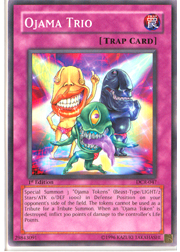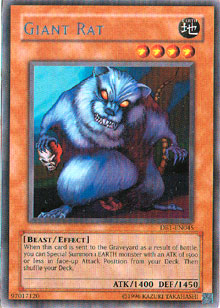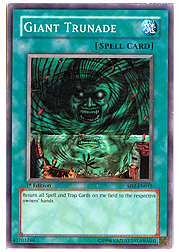It’s come to my attention that many of you out there on the Internet didn’t like my temporary name for Elemental Hero Wildedge very much. Come on, guys, you’ve got to admit that it was at least a little bit clever, and highly appropriate, considering the card’s effect. If that doesn’t change your mind, we’ll just have to agree to disagree on the merits of Angryman as a descriptive name and instead focus our attention to a point that I’m sure we can agree on. Elemental Hero Wildedge is an absolute monster if you can summon it. That’s why today I’m building an unorthodox version of an Elemental Hero deck that tries to make good use of Wildedge’s lack of anger management skills.
 It’s a proven fact that Ojama Trio makes me angry. It makes me angry when Jason plays it, it makes me angry when Curtis plays it, and it makes me angry when I play it. In fact, whenever I see Ojama tokens, I can’t help but try to wipe them off the face of the planet. This deck plans to do just that by using Elemental Hero Wildedge and Level Limit – Area A to swing in on every Ojama in sight to deal a mean 8700 damage to your opponent in one turn. I told you before that you wouldn’t like me when I’m angry.
It’s a proven fact that Ojama Trio makes me angry. It makes me angry when Jason plays it, it makes me angry when Curtis plays it, and it makes me angry when I play it. In fact, whenever I see Ojama tokens, I can’t help but try to wipe them off the face of the planet. This deck plans to do just that by using Elemental Hero Wildedge and Level Limit – Area A to swing in on every Ojama in sight to deal a mean 8700 damage to your opponent in one turn. I told you before that you wouldn’t like me when I’m angry.
“JEROME SMASH!”
Monsters: 17
3 Elemental Hero Clayman
3 Elemental Hero Wildheart
2 Elemental Hero Burstinatrix
3 King of the Swamp
1 Gyaku-Gire Panda
1 Sangan
1 Mystic Swordsman LV2
2 Giant Rat
1 Morphing Jar
Spells: 15
1 Dark Hole
1 Heavy Storm
1 Swords of Revealing Light
1 Mystical Space Typhoon
2 Smashing Ground
2 Enemy Controller
2 Giant Trunade
1 Polymerization
2 Miracle Fusion
2 Reinforcement of the Army
Traps: 8
3 Ojama Trio
3 Sakuretsu Armor
2 Level Limit – Area A
Fusion Deck: 9
3 Elemental Hero Wildedge
3 Elemental Hero Rampart Blaster
3 Elemental Hero Flame Wingman
When I say unorthodox, I mean unorthodox. I’ve chosen to ignore many of the good Elemental Hero support cards in building this deck, including Skyscraper and Hero Signal. Why have I decided to do this? First, I don’t plan on attacking anything that’s bigger than my monsters. In fact, the only things I’m planning on attacking are a bunch of hapless Ojama Tokens.
 Hero Signal isn’t in the deck because I’m using Giant Rat. Giant Rat can get me almost any monster in the deck, as opposed to Hero Signal, which would allow me to search for Burstinatrix, but not Gyaku-Gire Panda or Mystic Swordsman LV2. It would also involve having to give up a card in addition to the destroyed monster to do any searching, and this deck just doesn’t have room for such a thing when the variety of monsters that Hero Signal would fetch isn’t that that great. Basically, I can do everything with Reinforcement of the Army, Sangan, and Giant Rat, so I don’t need any more monster search cards. Finally, Elemental Hero Bubbleman didn’t make the cut because it doesn’t help me achieve my goal. Draw two cards if I have absolutely nothing else? Great, but if I’m left in that situation, the game is essentially over. Besides, with Ojama tokens taking up a lot of the opponent’s monster card zones, Don Zaloog and Spirit Reaper don’t exactly have a place to go.
Hero Signal isn’t in the deck because I’m using Giant Rat. Giant Rat can get me almost any monster in the deck, as opposed to Hero Signal, which would allow me to search for Burstinatrix, but not Gyaku-Gire Panda or Mystic Swordsman LV2. It would also involve having to give up a card in addition to the destroyed monster to do any searching, and this deck just doesn’t have room for such a thing when the variety of monsters that Hero Signal would fetch isn’t that that great. Basically, I can do everything with Reinforcement of the Army, Sangan, and Giant Rat, so I don’t need any more monster search cards. Finally, Elemental Hero Bubbleman didn’t make the cut because it doesn’t help me achieve my goal. Draw two cards if I have absolutely nothing else? Great, but if I’m left in that situation, the game is essentially over. Besides, with Ojama tokens taking up a lot of the opponent’s monster card zones, Don Zaloog and Spirit Reaper don’t exactly have a place to go.
This brings me to the first advantage that this deck has over the standard Cyber Dragon/Warrior Beatdown builds. Ojama Trio wrecks Cyber Dragon like a bulldozer wrecks houses. Those tokens are monsters, and as long as they sit on your opponent’s field, he or she won’t be special summoning any Cyber Dragons. Nor will your opponent be tribute summoning them, as you can’t tribute Ojama tokens for a summon either. This means that your opponent can’t get through the defensive wall created by Elemental Hero Clayman without help from a card effect.
It also means that if a stalemate occurs due to an opponent’s inability to summon anything good, you can achieve a win through the effect of Elemental Hero Rampart Blaster. If it’s face up in defense position, Rampart Blaster is allowed to attack directly for an amount equal to half its ATK strength, so you can peck away like a Stealth Bird while your opponent scrambles to summon a monster that can take down the 2000 DEF of Rampart Blaster. Sure, Cyber Dragon can do it, but that’s the monster that you should probably be saving your traps for. Another way to hurt your opponent while he or she is locked down is by using the single copy of Gyaku-Gire Panda. With two Giant Rats and one Sangan, getting to your Panda should be a simple enough task, and even if the opponent does manage to destroy it with a spell or trap, that’s one less trap that can stop Rampart Blaster—or ultimately, Elemental Hero Wildedge.
 This brings us to the primary win condition of the deck. Why have you been locking down your opponent with Ojama tokens all this time? Because you’re getting ready to summon a 2800 ATK monster to beat them all up and deal 8700 damage to your opponent in one turn. To finish the game, you’ll need your opponent to have three Ojama tokens, and preferably nothing in the backfield. That’s what the Giant Trunades are for. You also need the tokens to be in attack position, as they’ve got 0 ATK and your Wildedge doesn’t have a piercing effect. This is where Level Limit – Area A comes in.
This brings us to the primary win condition of the deck. Why have you been locking down your opponent with Ojama tokens all this time? Because you’re getting ready to summon a 2800 ATK monster to beat them all up and deal 8700 damage to your opponent in one turn. To finish the game, you’ll need your opponent to have three Ojama tokens, and preferably nothing in the backfield. That’s what the Giant Trunades are for. You also need the tokens to be in attack position, as they’ve got 0 ATK and your Wildedge doesn’t have a piercing effect. This is where Level Limit – Area A comes in.
Your final move should look something like this: Activate Giant Trunade and chain with Level Limit – Area A.* Then summon Wildedge (either by Polymerization or Miracle Fusion) and go to town on the Ojama tokens. You’ll deal 2600 apiece in battle damage, along with an extra 300 damage per token from Ojama Trio’s lingering condition on the tokens.** That’s 7800 plus 900 for a total of 8700 damage and the game.
How does one go about playing this deck? Personally, I play it as a slow combo deck, rolling with the punches and trying to keep myself intact until I draw the pieces of the combo. If you decide to follow my path, your best opening play is one of the three search monsters in the deck and an Ojama Trio. You’ll want to activate Ojama Trio during your opponent’s draw or standby phase so that he or she has no opportunity to special summon a Cyber Dragon on you. From there, the decision-making passes over to the opponent, and his or her options aren’t particularly good. If your opponent chooses to play defensively, he or she is just buying more time for you to get what you need. After all, you aren’t planning to attack until it will win you the game, so you’ll love to see face down monsters on the opponent’s side of the field.
Other than that, try to use your traps sparingly by saving them for any monster that’s capable of taking out Elemental Hero Clayman or Elemental Hero Rampart Blaster. Monsters like Cyber Dragon and Mobius the Frost Monarch are going to be your biggest concerns when you’re up against most decks, so a useful modification to the deck might be to find some space for a couple copies of Mask of Restrict. Not only will it prevent Cyber Dragon and Mobius from ruining your day, you can also chain it to Soul Exchange to turn Soul Control players into sad, sad pandas. Speaking of Pandas, Gyaku-Gire Panda makes a great wall as it’s unlikely that your opponent will have a way to deal with it without wasting removal spells.
The main problem with the slow combo strategy is that if your opponent decides to overextend like mad, it may cost you in the end. I’m talking about the players who will happily throw down Dark Hole and Heavy Storm on the first turn just to get rid of the Ojama tokens and all of the stuff you brought to the field. These duelists will usually follow that up with Spirit Reaper or Don Zaloog to try and even up the card count, and by the time they’re through, it’s likely that both players could be topdecking. As I said above, topdecking is a bad situation to be in when you’re playing this deck, and that’s why it’s important for you to manage your cards carefully. No one likes to lose to Heavy Storm and Dark Hole, so if you don’t have to play all your cards, don’t do it. Morphing Jar is in here as a fail-safe in case this type of situation starts to occur, or if you’re willing to take the chance to try and dig for your last combo pieces. Just make sure you play Giant Trunade first and reset your cards before you do it in order to maximize your advantage in the situation.
The other way to play this deck is the aggressive combo method, which is something that I have little experience with. This method involves locking down the opponent by putting an Ojama token in every available monster zone as fast as possible. Then, pull out Rampart Blaster and start swinging for 1000 per turn, hoping that they don’t have the traps required to stop you from doing so. Finally, rather than using Wildedge, you actively try to beat the opponent up with Gyaku-Gire Panda, again ignoring the collective wisdom of combo players all over the world—because the truth is, you just like to smash things. Now that I think of it, if you like to smash things that much, you probably aren’t playing this version of an Elemental Hero deck. Personally, I like to lay in wait until I’ve built up a magnum opus of smashing to unleash on an unsuspecting opponent, which is a point that I’ll reiterate next week.
For all you Yu-Gi-Oh! GX fans out there, I’m sorry that today’s Elemental Hero deck wasn’t really made in the spirit of the show. Make sure to tune in next week for a deck that will give fans of the show a warm fuzzy feeling inside. Until next time, play hard, play fair, and most importantly, have fun!
Jerome McHale
jcmchale AT andrew DOT cmu DOT edu
NEXT WEEK: What would happen if the brothers Truesdale teamed up? “The Power of Television,” that’s what! Out of all the decks I’ve ever built, next week’s is one of my favorites to play. In fact, it’s so much fun that even my opponents can’t help but enjoy it.
*Yup, this works. Level Limit – Area A resolves first and forces all face up monsters of level 3 and lower into attack position, and then Giant Trunade picks it up. In contrast, if I activated Area A, and my opponent chained with Mystical Space Typhoon, the Typhoon would destroy Level Limit first—and since it’s no longer on the field, the continuous effect would fail to kick in when it came time to resolve the trap.
**Remember that this doesn’t mean that the tokens are effect monsters. Tokens are never treated as effect monsters. Any effects that might occur with the tokens are products of the cards that create them.